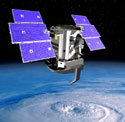|
 |
 |
|
| CloudSat - Looking at clouds in 3-D |
|
 |
 CloudSat (Photo: NASA)
CloudSat (Photo: NASA) |
Traditional satellites studying the atmosphere can portray the cloud surface accurately, but are limited to a two-dimensional representation of cloud cover. No data has been available on cloud
thickness that would help to determine volume and the quantity of water, snow, or ice clouds contain. But
this will change during the winter of 2005-2006, with the launch of CloudSat, a satellite that will gather new data and improve our knowledge of clouds and their effect on climate. CloudSat was developed by NASA in partnership with the Canadian Space Agency. |
Why clouds?
 |
|
Clouds influence the amount of solar energy retained in the atmosphere and the amount reflected back into space. Even small changes in cloud cover can alter climate in a major way. Some scientists think clouds may affect our climate even more than greenhouse gases and other factors linked to climate change. (Photo: NASA) |
The mission
CloudSat will be doing the first comprehensive three-dimensional study of clouds. It will gather data on their structure, frequency and volume, and will help improve our understanding of how they influence the weather. It will use a radar hyperfrequency device to probe the cloud cover and determine its thickness, its altitude at base and peak, and the quantity of water and ice contained.
High Resolution – 811KB
(Windows Media Player)
Low Resolution – 140KB
(Real Player) |

This animation shows how CloudSat will conduct its mission
(Courtesy of NASA) |
CloudSat will also analyze the way light is absorbed by the various layers of the atmosphere, particularly the influence of atmospheric aerosols on this process. Scientists will also fill in gaps in their knowledge of how radiation energy from the Sun and the Earth is distributed between the Earth's surface and the atmosphere
The mission will also refine and validate data gathered by other atmospheric and cloud research satellites.
A constellation of satellites
A distinct feature of CloudSat is its role in a constellation of scientific research satellites. This constellation, known as the A-Train,
also includes: CALIPSO, which will be launched at the same time as
CloudSat aboard a Delta rocket, as well as Aqua, Aura, and
PARASOL which are already active in the skies. A sixth satellite,
OCO, will be launched in 2008.
CALIPSO is a joint United States/France mission. It will collect data on the role played by transparent, thin clouds and aerosols in the transfer of solar energy to the atmosphere.
The Aqua satellite has numerous instruments on board to collect data on the Earth's atmosphere. Once all satellites are launched, it will be
at the head of the pack. Aura, at the back of the formation, will study air quality, the ozone layer, and climate change. PARASOL, a mission led by France, researches how light is diffused by clouds and atmospheric aerosols. This mission affords a better understanding of the impact of human activity on global warming.
Canada is in the thick of it
Since Canada has expertise in space radar, NASA invited the Canadian Space Agency (CSA) to participate in the CloudSat mission in 1998.
Ontario companies CPI, of Georgetown, and COM DEV, of Cambridge, answered the CSA's call for
tenders for this mission . These two space industry leaders developed a key element of the cloud profiling radar, the extended interaction klystrons (EIKs), as well as a central component of an electronic receiver: the radio frequency electronics subsystem or RFES. A klystron is a specialized electronic tube similar in concept to those used in microwave ovens. It will generate radar waves that will be used by CloudSat to probe the vertical structure of clouds.
| CSA will also provide support to Canadian scientific investigations related to the mission. David Hudak, Ron Stewart, and Howard Barker of the Meteorological Service of Canada will be helping the U.S. team. Jean-Pierre Blanchet, of the Université du Québec à Montréal, is also a member of the CloudSat mission research team. Together, they bring to the mission their expertise in a variety of disciplines ranging from general atmospheric science to the improvement of computer algorithms and data checking.
The American Principal Investigator for the CloudSat mission is Graeme Stephens of Colorado State University. Construction of the satellite platform is the responsibility of Ball Aerospace. |

This painting of CloudSat was created by the mission's Principal Investigator.
(© Graeme Stephens) |
A multipurpose mission

Clouds over the Indian Ocean
(Photo: NASA) |
Cooperation with other space agencies, governments, and scientists is part of the Canadian Space Agency mandate for supporting Canada's role in international space development. Canadian space technology advances the body of knowledge available about climate and enhances the forecasts developed by the scientific community for weather and climate change. |
| Canada invests in the CloudSat program to encourage remote sensing and telecommunications applications design and development. |

CloudSat
(Image: NASA) |
For more information, please visit:
|